Road Trip: Exploring the Grand Canyon, part 3
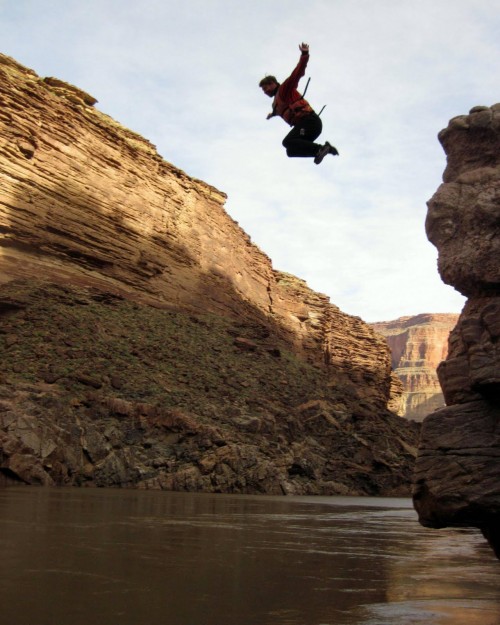
[The third installment in our ongoing Road Trip series, in which Institute staff visit other amazing places around the country and bring back stories and photos to share! This article is the final installment in a three-part series.]
After spending 11 days on the Colorado River, we took a rest on our twelfth day and set forth on land to discover the wonders of Tapeats Canyon. There are stories that a waterfall cascades down the canyon wall for hundreds of feet to the canyon floor with feats of grace. Cottonwoods grow along the river’s edge while mosses and ferns carpet the canyon wall. After 11 days on the Colorado, where the majority of the plants we saw were of the cactus family, Cactaceae, we were driven up the canyon to explore paradise.
We set out on our hike that morning with two goals in mind: to reach paradise and move our legs that had atrophied after sitting for 11 days.  We journeyed up Tapeats Creek and passed under cottonwood trees and redbuds, whose leaves were changing color with the arrival of fall. While traveling through the canyon I felt as if we were moving through a painting.  We were surrounded by colors of deep reds, dark blues, bright greens, vibrant yellows and muted tans. After traveling for 2 hours on a trail that already seemed to be the entryway to Eden, we reached Thunder River.
Exploring the Thunder River.  The size of this wall is shown by taking note of the size of the people on the cliff in the far left corner of the photo. Photo by Frankie Devlin
After such an amazing day at Thunder River, we decided to sacrifice river miles and take advantage of our ability to explore this beautiful place over the next few days. As a result, we found ourselves pulling into the blue waters of Havasu creek.
We followed the turquoise water of Havasu up through cacti and over sand bars.  We weaved through thickets of wait-a-minute bushes, whose name stood clear as it would catch on to you, holding you back for a brief second as your friends moved on. We waded through the ice-blue water, marveling at its beauty as the current flowed between our legs. After a few miles of exploring we reached Beaver Falls. The Supai Indians deemed these falls the “Center of the Universe,” as translated from the name “Havasu.”
Havasu Canyon and the falls that reside within it’s dark, red walls is indeed the center of the universe. The beauty of the blue water immediately made me forget that I had just spent the past 2 hours walking in the rain with the temperature hovering in the upper 40s. We had experienced our second significant storm on the river that day, with high winds, bitter cold temperatures and pounding rain. We would welcome the clearing skies, even though it meant we would see snow on the upper canyon walls. It was late November, which meant the canyon was transitioning to the winter months, and that we had to prepare Thanksgiving dinner on the sandy beach of National Camp.
Entrance to Havasu Creek. Photo by Luke Lydiard
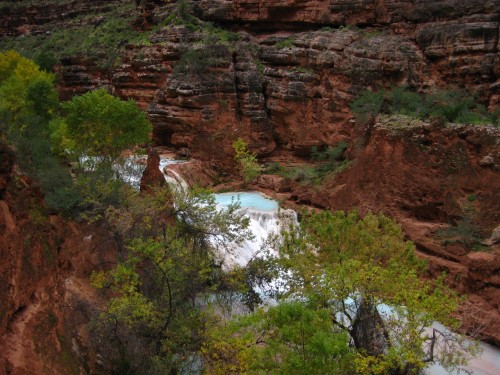 Beaver Falls located in Havasu Canyon. Photo by Stephanie Bennett
Beaver Falls located in Havasu Canyon. Photo by Stephanie Bennett
In order to keep the trip interesting, my friend Gretchen and I deemed ourselves party commissioners. Before we departed down the Grand Canyon we notified group members that Thanksgiving this year would be a themed dinner, which included “Come as your Favorite Explorer” or “Relive your Prom.” Our group of 16 did not disappoint. Thanksgiving dinner was prepared by Leif Erickson and John Wesley Powell. In attendance were Alice (from Wonderland), Pocahontas, a PCT Thru-hiker, Shackleton, and our formal wear attendee’s decked out in flannel dresses, tuxedo’s and animal prints. Thanksgiving dinner on the river consisted of slices of turkey, tofurkey, stuffing, mashed potatoes and pie. It was a true feast!
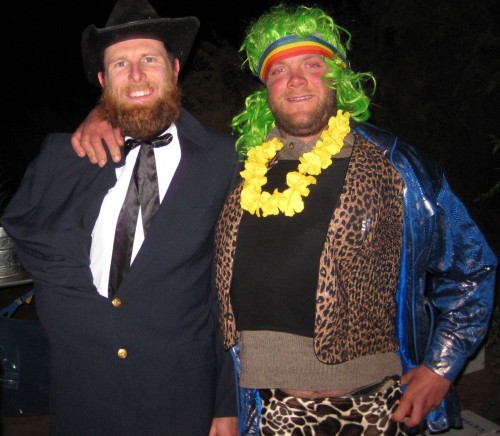 Chris dressed as John Wesley Powell (left) and Kenny dressed as his lady friend arrive to Thanksgiving dinner in style. Photo by Stephanie Bennett
Chris dressed as John Wesley Powell (left) and Kenny dressed as his lady friend arrive to Thanksgiving dinner in style. Photo by Stephanie Bennett
The next day was cut short since we had to prepare for Lava Falls rapid, located at mile 179 on the Colorado. The rapid is believed to be created by remnants of basalt rock and various lava flows that emanated from the ominous Vulcans Throne, a cinder cone located on the canyon rim. Lava Falls is rated a 9 on the Grand Canyon rapid scale, due to the heavy consequences–if you do not have a perfect line going through Lava, your raft can be torn to shreds in the churning water. In the center of Lava Falls is a 30 to 40 foot-long pour over called “the Ledge,” which creates a gigantic, churning vortex known to suck rafts in and destroy them. An example of the potential danger through this section of rapids is seen in the following video taken from another trip.
[youtube]http://www.youtube.com/watch?v=38fzPEq2W1U[/youtube]
Note: this video is not from my trip and no one was injured… except the raft and the ego of the oarsmen.
If you are so lucky to miss the Ledge, you are then faced with two very large V-shaped waves followed by one last gigantic wave that feels as if you are climbing two flights of stairs as you crest the top. Edward Abbey provides encouraging words for those who flow down the tongue of Lava Falls:
Twenty seconds and it’s all over. Twenty seconds of total truth and then we’re cruising through the tail of the rapid, busy with the bailers, joining the procession of dories before us. Nothing to it. Like I always say, running the big rapids is like sex: half the fun is in the anticipation. Two-thirds of the thrill is in the approach. The remainder is only ecstasy – or darkness.
I personally hoped for ecstasy over darkness.
When in the Grand Canyon, the difficulty of running particular rapids can change due to large releases of water from the Glen Canyon Dam, which controls the amount of water flowing in the river at that very moment. These releases contribute to the challenge of running Lava Falls. The dam regulates the river’s flow between 8,000 to 16,000 cubic feet per second each day in the winter. Massive rain storms and flash floods add to the excitement by significantly increasing the flow and creating the dark brown color of the water, as seen in the video. The dam is also now required to release a large amount of water each year in order to aid the river in reclaiming its shoreline from the invasive tamarisk and other non-native species.
The Glen Canyon Dam has impacted the Grand Canyon eco-system. This impact is visible to the river traveler every day of their journey. From ease of finding a camp site to wading through millions of Tamarisk, the canyon is not the same landscape that John Wesley Powell traveled nearly 150 years ago. When Powell traveled down the brown waters of the Colorado, the Tamarisk was not found on the banks that it now chokes. The beaches were more prevalent, as the river could flow at varying natural levels that moved boulders and replenished sand on the way side. Most importantly, it is believed that the river Powell and his men floated was tamer than what the current-day oarsmen row through. During massive flood stages, the river would roar to 100,000 cubic feet per second moving rocks at the base of debris-fans and depositing further down stream. With the dam blocking this massive surge of water, the river is no longer powerful enough to scour rapids and move rocks further downstream. Man has found a way to tame the mighty Colorado.
Prior to attempting the Lava Falls rapid we painted our faces to appease the Lava gods, and prepared ourselves for the challenge ahead by scouting the rapid on the right side. As we pulled our boats onto a beach far above the rapid, I could already hear the deep roar of the water below. As I walked the sandy path to a rocky outcropping above the rapid, I could feel my hands begin to tremble slightly. I came upon our oarsmen who were standing silently while watching the river flow over rocks and churn into waves and dark holes. I took a seat next to them and remembered, it will only take 20 seconds. I took another deep breath, and we were ready to go.
Nels appeasing the Lava Gods. Photo by Stephanie Bennett
The “safer” time to travel through Lava Falls on November 27th was at noon, when the river flow would be high and the sun would be shining on our painted faces. We boarded the rafts just before noon and began our 20-second journey toward ecstasy. Stewart was at the oars as we followed second behind the raft rowed by Scott. I turned to Stew to give him a high-five, my own way to calm myself and remove the anxiety of flowing closer to the beginning of the rapid. Stew looked at me and said “Not now, I need to focus” and we flowed down the tongue, missing the Ledge and ran head on into the first giant wave. The boat reared up like a horse trying to buck you off, and within an instant we crested the wave, came down the back side and saw the next wave right in front of us. The boat went up again, climbing to a height that all I could see in front of me was blue sky.The raft soared over the top and was pushed sideways. Water poured over the front of the boat, filling to my waist. Before I had time to register what was happening, we slammed into the next wave and flew up and over a wave that seemed to tower 10 feet over my head. We were through! We floated up next to Scott’s raft and we were all cheering since both of us had made it through. Ecstasy.
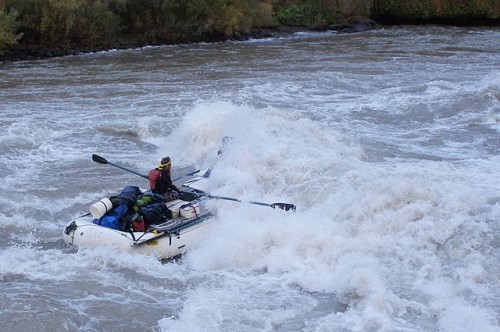 Scott leads the drop into Lava Falls, making for a clean run. Photo Frankie Devlin
Scott leads the drop into Lava Falls, making for a clean run. Photo Frankie Devlin
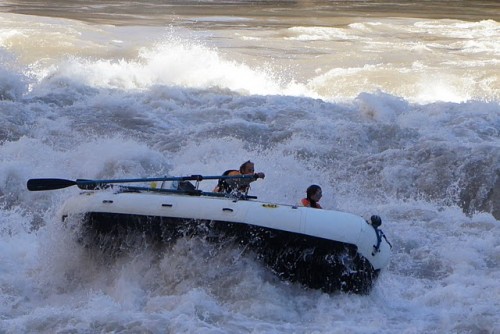 Stew makes the second drop into Lava as he squares up to hit the waves straight on. He runs the rapid clean. Photo by Frankie Devlin
Stew makes the second drop into Lava as he squares up to hit the waves straight on. He runs the rapid clean. Photo by Frankie Devlin
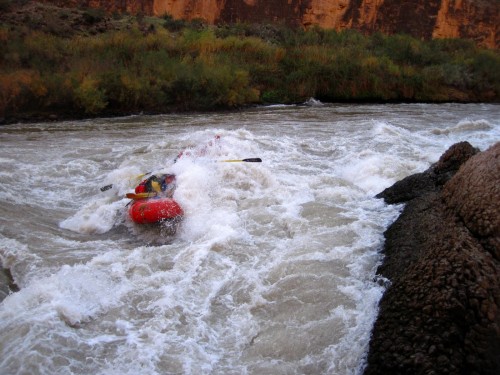 Ryan makes the third drop but moves too far to the right. He’s able to correct himself and runs the rapid clean. Photo by Frankie Devlin
Ryan makes the third drop but moves too far to the right. He’s able to correct himself and runs the rapid clean. Photo by Frankie Devlin
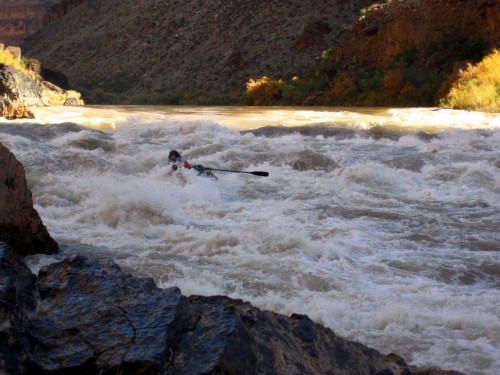 Chris searches for the infamous bubble line near the ledge. He makes it through lava without a hitch Photo by Frankie Devlin
Chris searches for the infamous bubble line near the ledge. He makes it through lava without a hitch Photo by Frankie Devlin
Afterward we all took to the beach below the rapid like a storm, where celebration immediately ensued. We celebrated a successful day through Lava, which was beyond our expectations.  The day ended as we lazily floated down the river, beers in hand as the setting sun disappeared over the canyon wall.
The last two days of our voyage were spent reflecting on our journey through the Colorado and imagining what a hot shower would feel like upon our return to Flagstaff, Arizona. On our final evening together we had a joyous feast around the campfire and recounted stories from the trip. On the morning of our 20th day, we loaded the rafts one last time and floated the remaining 2 miles to the pull out at Diamond Creek. No one spoke as we took apart the rafts and set our gear upon the shore. As the rigging came off and the boats were deflated, some of us stood silently and watched as our life on the river was packed away. We took our only group photo from the entire trip before we loaded into the vans and drove away from the mighty Colorado River. We reflected on the closing words in Edward Abbey’s journal:
Night and day the river flows. If time is the mind of space, the Colorado is the soul of the desert. Brave boatmen come, they go, they die, the voyage flows on forever. We are all canyoneers. We are all passengers on this little living mossy ship, this delicate dory sailing round the sun that humans call the earth. Joy, shipmates, joy.
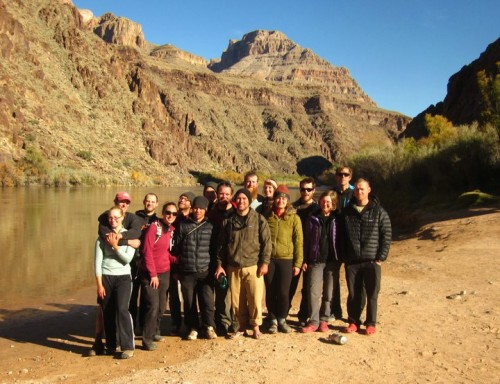 The group on the last day at Diamond Creek pull-out. Photo by Gretchen Leggitt
The group on the last day at Diamond Creek pull-out. Photo by Gretchen Leggitt
Since returning from the voyage, the first question I am typically asked is “How was it?” Nearly a month later I still do not have an answer I feel satisfied with. Simply put, I had an opportunity that few do–to travel down a river and through a canyon that has colors and shapes I have never seen before, and cannot describe. The experience was so powerful that my heart still aches when memories float into my mind from the trip, and I cannot return to recapture them. I feel tied to a place I have only seen once, and will always be drawn to return to. The Grand Canyon is more than Grand, it truly is the center of the universe.
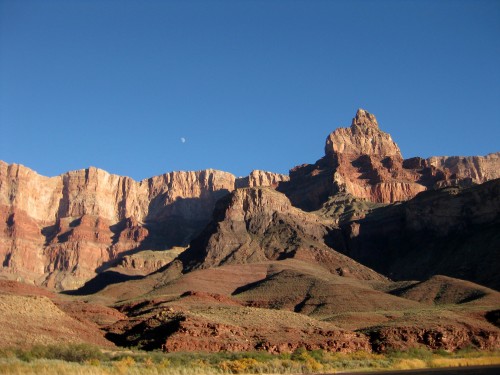 Views from Main Nankoweap. Photo by Stephanie Bennett
Views from Main Nankoweap. Photo by Stephanie Bennett
I invite you to look at more photos from our trip on picasa. Each group member who has contributed photos has loaded them under their own folder name. Please feel free to peruse!
In addition, I invite you to explore the following references used before, during and after our journey. Â I can assure you they all fit into a 20-liter dry bag, and are worth the weight.
Guide to the Colorado River in the Grand Canyon, by Tom Martin & Duwain Whitis
The Hidden Canyon: A River Journey, by John Blaustein & Edward Abbey
The Exploration of the Colorado and Its Canyons, by John Wesley Powell
A Field Guide to the Grand Canyon, by Stephen Whitney
Belknap’s Waterproof Grand Canyon River Guide, by Buzz Belknap & Loie Belknap Evans


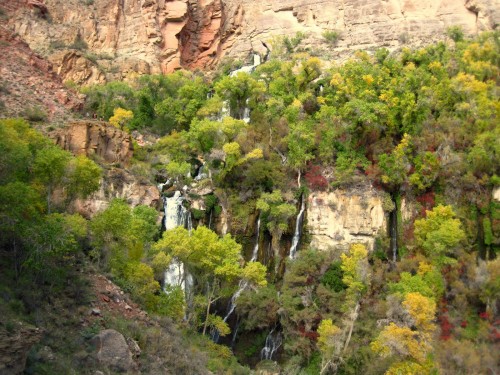
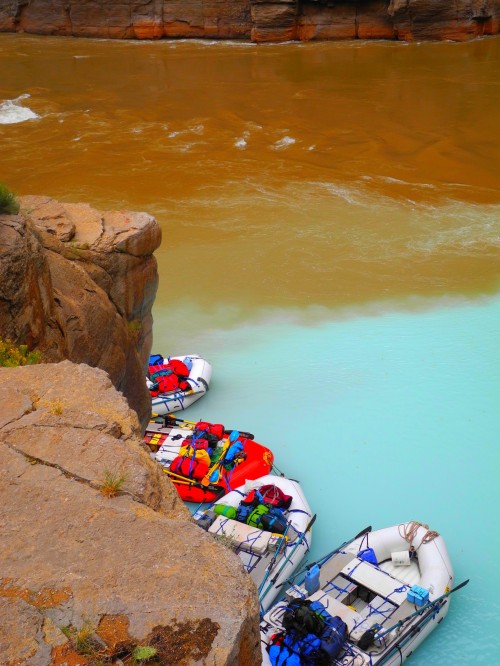
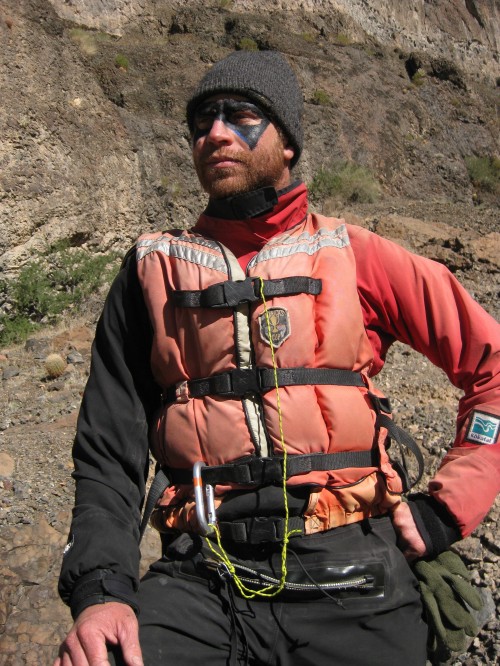
Thanks for sharing your adventure. What an amazing trip!
This has been a great series of tales, adventures and natural & cultural history. Appreciate you sharing this for us armchair explorers stuck back home in the rain…